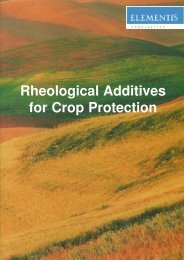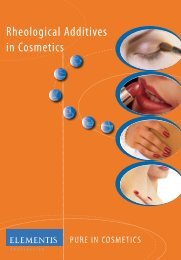Comparison of Smectite Clays in Underarm Products - Elementis ...
Comparison of Smectite Clays in Underarm Products - Elementis ...
Comparison of Smectite Clays in Underarm Products - Elementis ...
Create successful ePaper yourself
Turn your PDF publications into a flip-book with our unique Google optimized e-Paper software.
What are <strong>Smectite</strong> <strong>Clays</strong>?<br />
<strong>Smectite</strong> clays belong to a family <strong>of</strong> layered m<strong>in</strong>erals that are comprised <strong>of</strong> <strong>in</strong>dividual<br />
platelets with a metal oxide center sandwiched between two Silicone Dioxide outer layers.<br />
Included <strong>in</strong> this group <strong>of</strong> m<strong>in</strong>erals are Hectorite, Bentonite (Montmorillonite), Saponite,<br />
Sepiolite, Beidellite, Nontronite and Sauconite. Of these, Hectorite and Bentonite are the<br />
most important because <strong>of</strong> their swell<strong>in</strong>g properties and availability.<br />
Because <strong>of</strong> the structure these clays build after they swell <strong>in</strong> water, they have become<br />
commercially important as rheological additives, or flow control agents. In the cosmetics<br />
<strong>in</strong>dustry, clay based products are used to improve properties such as suspension,<br />
emulsion stability, viscosity, thermal stability and spreadability.<br />
Structurally, Bentonite is a dioctahedral, Alum<strong>in</strong>ium based clay, while Hectorite is a<br />
trioctahedral, Magnesium based clay. This structural difference leads to differences <strong>in</strong> the<br />
chemistry and physical properties <strong>of</strong> the two clays. In addition, Hectorite does not conta<strong>in</strong><br />
any crystall<strong>in</strong>e Silica.<br />
Both Bentonite and Hectorite clays can be reacted with organic compounds to form<br />
organophilic clays. These swell <strong>in</strong> anhydrous media and ma<strong>in</strong>ta<strong>in</strong> the same physical<br />
properties <strong>of</strong> the reacted hydrophilic bases; i.e., Hectorite based organoclays have a<br />
lighter colour, lower iron content and greater viscosity efficiency. In Table 1 we can see<br />
the general properties <strong>of</strong> Hectorite and Bentonite.<br />
Hectorite Bentonite<br />
Chemistry Na 0.33 [Mg 2.67 Li 0.33 ]Si 4 O 10 [OH] 2 Na 0.33 [Al 1.67 Mg 0.33 ]Si 4 O 10 [OH] 2<br />
Platelet Shape Elongated Equidimensional<br />
Platelet Size<br />
(dispersed)<br />
0.8 x 0.08 x 0.001 microns 0.8 x 0.8 x 0.001 microns<br />
Type Trioctahedral Dioctahedral<br />
Swell<strong>in</strong>g Ability 35 x 15 x<br />
Colour Light P<strong>in</strong>k to Tan Grey to Green<br />
Iron (typical) 0.2% 2.3%<br />
Viscosity<br />
(5% concentration)<br />
Table 1. Typical properties <strong>of</strong> Hectorite and Bentonite<br />
10000 mPa.s 750 mPa.s<br />
2







